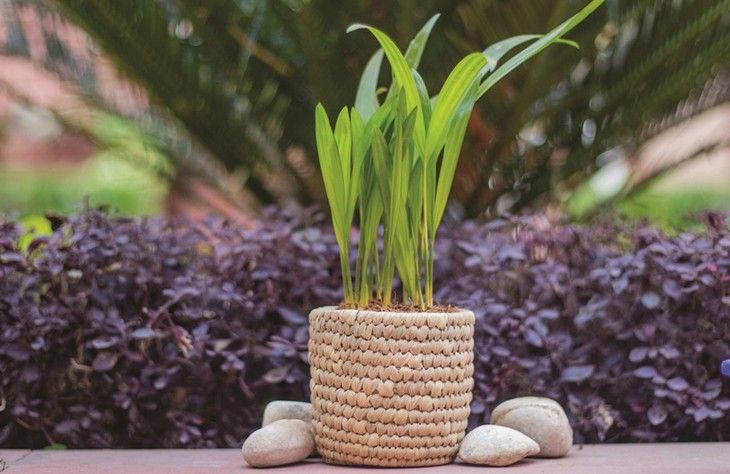Sabai Grass (Eulaliopsis binata) is a perennial plant that belongs to the grass family and is grown in countries like India, Pakistan, China, Nepal, Bhutan, Myanmar, Thailand, the Philippines, and Malaysia. It is characterized by long leaves which are used for making ropes, pulp for paper production, and many other arts and crafts. In India, Sabai grass is abundantly found in the forest fringes of the Chota Nagpur Plateau in West Bengal and Odisha.
Sabai Grass Crafts
It is believed that Sabai grass got its importance during the British era when they found it strong and durable enough for military use. At present Sabai grass, craft making has become very popular in various districts of West Bengal and Odisha like Purulia, Bankura, Jhargram, Mayurbhanj, and Baripada. Although earlier it was used for rope-making and making paper pulp, now it is stylized in various ways for making items like wall hangings, cots, furniture, baskets, decorative boxes, and coasters. Sabai grass being light, easy to dye, and work with, has gained popularity nowadays for making eco-friendly daily use as well as fancy products.
Techniques of the Crafts
Sabai grass rope is the primary item that is made from the grass which is later used for making and giving shape to other items like baskets, cots, furniture, etc. The various techniques of Sabai grass craft are harvesting and cutting, rope making, braid making, dyeing, and weaving. The techniques are explained as follows:-
- Harvesting, Cutting, and Bunching - The grass is harvested during May and June. After reaping and cutting,the grass is thrashed on the floor for softening, then it is sun-dried and bundled for further use.
- Rope Making - After the harvesting and cutting process, the dried grass is twisted and tightened using a cycle ring. The rope is smoothened and removal of the rough edges is done by rubbing them along tree trunks. At present, artisans also use twisting machines for twisting the dried grass to make the rope. After the rope is prepared, they are arranged in bundles.
- Braid Making - The grass is sorted according to quality and length. Then the braid is made according to a similar hair braiding process and it is handmade. After the braid making is done, the rough edges are cut off. The braid making provides strength and durability to the rope.
- Dyeing - Generally, the grass strands are dyed using natural and vegetable colours. Nowadays, craftsmen also use Azo-free dyes for adding vibrant colours to weave the product. The strands are first to cut into desired lengths, bunched appropriately for giving the desired shape. Then the colours are mixed in required proportions and mixed in boiling water. Then the strands are also added into that boiling water containing the dyes and soaked well till the dyes are mixed with each and every strand. Finally, the coloured strands are dried in the sun.
- Weaving - The Sabai grass threads hence formed are weaved using needles into desired shapes and designs. Utility items such as baskets, mats, and planters are crafted. Several decorative products are created as well by weaving the material.
Sabai Grass Craft Industry and Impact on Economy
The areas where Sabai grass is grown are predominantly affected by the scarcity of water. So different kinds of crop cultivation are not possible in such areas. That is why people, mostly women in these areas, took up rope making from Sabai grass as their profession. Gradually with training, they switched to craft making with Sabai grass and that has been a huge turnaround for the economy of these areas. These various Sabai grass crafts have been liked and appreciated by people from far and near and there has been an increasing demand for Sabai crafts in both domestic and international markets which have, in turn, improved the economic conditions of the artists. The major contribution to this transformation is because of the efforts of the Self Help Groups present in these areas. They have provided the artisans with the necessary training and opportunities to showcase the indigenous craft at various levels.
Current Scenario
Sabai grass craft artists regularly participate in various fairs and exhibitions from where they directly interact and sell their products to customers. Moreover, the improved tourism industry in the Chota Nagpur Plateau has also given a huge scope for the artists to showcase their crafts to a large number of tourists. Unfortunately, the worldwide Coronavirus pandemic affected these sectors badly and the whole trade suddenly came to a standstill. Again the Self Help Groups came into action and provided the artisans with the required internet education so that now they can sell their Sabai grass products on the various popular online platforms. www.ARTSofINDIA.in is such a platform that has come forward to the cause of art and artists. Other than that, ties with major craft retailers like Biswa Bangla, Manjusha, Kadam Haat, Sasha, etc along with various help from various government schemes of both West Bengal and Odisha Government have revived the hopes among the artists to propagate their indigenous art in full swing.
Picture Source: ARTSofINDIA



